Review: Civic Theatre spells hilarious, poignant with Putnam County Spelling Bee

Oh those middle school years, we remember them well. The humiliation, the anxiety, the bullies, the stress, the dire need to be good at something, what a wonderful time it was.
The Ann Arbor Civic Theatre is presenting a happy bit of nostalgia with The 25th Annual Putnam County Spelling Bee, a musical salute to all those anxiety-ridden kids who strived to be top speller.
The Lydia Mendelssohn Theatre on the central University of Michigan campus is a perfect setting. The stage is simply decorated with a banner for the spelling bee, sponsored by the county optometrists, a riser of bleacher seats, a microphone and a table for the two adult hosts.
Spelling Bee takes a quirky, exaggerated look at some gawky budding adolescents and plays it for laughs that lead to some empathy and respect for the troubled young people who often get noticed for all the wrong reasons in school. Director Wendy Sielaff has brought together a fine cast that ham it up hilariously while also delivering the goods when called on to go deeper into character.
The music by William Finn is serviceable but the lyrics are used to convey those deeper feelings, while Rachel Sheinkin’s Tony-winning book richly skewers school life, spelling bees, and the cluelessness of adults.
We know the types. Here they are played not by middle-school-aged children but by older actors in reflection of those trying years.
Emily Fishman is sweet and appropriately apprehensive at Olive, dressed in an innocent pink jumper. Olive is torn between two neglectful parents and wants to finally get their attention. Fishman has a ringing voice, especially effective in "The I Love You" trio with her parents.
Nathan King is the goofy Leaf Coneybear, the non-achieving younger brother who gets no respect at home. But then again he dresses weirdly and shouts a lot. King brings a touch of Jerry Lewis to Coneybear but also some sweet pathos to "I’m Not That Smart."
Keshia Daisy Oliver is Logainne, the daughter of two gay fathers who want her to succeed a little too fervently. Oliver also finds the spot of empathy and a sweet moment of rebellion.
Bob Cox plays Chip, a boy moving into manhood at just the wrong time. Cox is dressed as a Boy Scout with too many merit badges. He is especially funny in "Chip’s Lament," a ditty about the betrayal of puberty.
Hallie Fox is Marcy, the over-achiever, the success-obsessed Catholic schoolgirl who sums up her anxiety with the song "I Speak Six Languages." Fox gives the character that determined to demented look and snappish voice of a future politician.
Finally, we come to the most outlandish contestant, Barfee (or as he insist, it’s pronounced Barfay). Connor Rhoades goes all out in his wrinkled white shirt, tie and shorts. Barfee is a big boy and the ultimate nerd who uses his foot to help him spell. Rhoades is a giant presence throughout but takes center stage with the "Magic Foot" number. He makes Barfee both anxiety ridden, pathetic, and strangely likeable. Rhoades also plays one of Logainne’s Dads (think Modern Family, here).
The other contestants are played (filled?) by good sports selected from the audience, who on Thursday provided some gentle laughs of their own.
The adult roles are also well played. Alison Ackerman is Rona, the teacher who never got over her success at the Bee. She is every bit the prim but enthusiastic teacher who misses the limelight. Ackerman also plays Olive’s absent in India mother in the "Love Song" trio.
Brandon Cave is excellent as the droll assistant principal Doug Panch who gives the spellers their words and much more. He gets some of the shows wittiest lines and he delivers them with low-key panache.
Finally, we have Nick Rapson as the coach who fills in as the sympathetic comforter of the “losers,” and he has just the right amount of sweet toughness and skepticism about the whole process. Thursday he had some humorous improvisation during his "Prayer of the Comfort Counselor" spotlight and made it special. Rapson also plays Olive’s Dad in the "Love Song" trio and is a hoot as Logainne’s other Dad.
Musical accompaniment by an on-stage five-piece band under the direction of Debra Nichols is solid, especially on some of the humorous percussion moments. Reilly Conlon brings the right clumsy humor and daffiness to the choreography.
Sielaff says this play has long been on her bucket list and now she can check it off as a success. She mines both the outsize humor and the quiet empathy that has make this a popular production across the country.
Hugh Gallagher has written theater and film reviews over a 40-year newspaper career and was most recently managing editor of the Observer & Eccentric Newspapers in suburban Detroit.
The 25th Annual Putnam County Spelling Bee continues at 8 pm Friday and Saturday and 2 pm Sunday at the Mendelssohn. For tickets and information, go online to http://www.a2ct.org, call (734) 971-2228, or purchase at the theatre before each performance.
Review: Theatre Nova's Dear Elizabeth
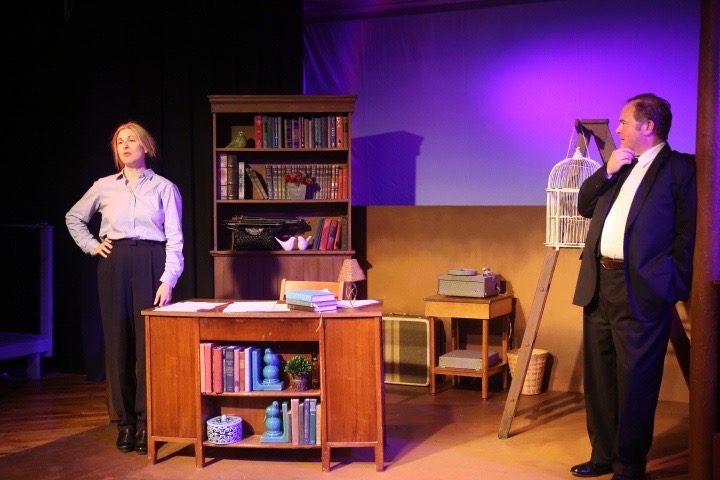
While watching Theatre Nova’s lovely new production of Sarah Ruhl’s play, Dear Elizabeth, drawn from 30 years of correspondence between poets Elizabeth Bishop and Robert Lowell, the phrase “alone together” comes to mind often.
Why? Because although they both experience love off-stage – Bishop with a woman in Brazil named Lota, Lowell with three different wives – their true first love is words; and like a jealous, possessive lover, words, when you’re a professional writer, demand that you spend most of your waking life alone with them, and only them.
So it’s not surprising that Lowell and Bishop – who lived a similarly isolated artistic existence, and consequently understood each other deeply – flung letters to each other as if they were life preservers.
In life, Lowell and Bishop wrote more than 800 letters to each other, offering praise and feedback for each other’s work; celebrating each others’ awards and personal victories; and chronicling their travels, as well as their battles with inner demons (Bishop’s depression and alcoholism, Lowell’s bipolar disorder). Not surprisingly, even the prose of their casual letters rings gorgeously poetic; in reference to a lighted swimming pool, Bishop wrote, “it is wonderful to swim around in a sort of green fire. One’s friends look like luminous frogs.”
The inherent challenge of an epistolary play, of course, involves giving the audience something to watch, not simply listen to. Ruhl lays the foundation for a visually satisfying production by way of stage directions, calling for occasional projections, and giving the actors a template for connecting scenes through actions; they also “live” certain quirky moments as they speak the words of their letters instead of pretending to write them.
But director David Wolber gets much credit, too, for adding his own creative touches, effectively using props, different areas of the set, and a movement pattern for the actors – partly inspired by Lowell’s frustrated observation that the two poets seem connected by a wire, so that when one moves, the other does as well – that keeps the audience engaged.
Another tricky prospect, however, involves how to present the poets in their moments of weakness, such as when Bishop pulls two filled wine glasses from her desk to drink. It’s initially funny, but when she then pulls out a bottle of rubbing alcohol and downs that, too, we know we’ve suddenly gone down the rabbit hole of addiction. Wolber and actress Carrie Jay Sayer handle the shift with sensitivity, not playing it too heavily or too lightly, but rather suggesting a haunting, all-too-natural progression into darkness. (Wolber specializes in plays about artists and the process of creation, so play and director are ideally matched here.)
Joel Mitchell is marvelous and heartbreaking as Lowell, a man who struggles mightily in his own life, and uses that as material for his confessional poetry. Sayer, meanwhile, is well-cast as Bishop, conveying the emotionally guarded poet’s simultaneous desire to connect to Lowell while also always maintaining an arm’s length distance; and the actress nails a running gag wherein, after showering Lowell with praise over a poem or collection, she pauses and says something like, “There are just three words I take objection to,” or “I have two minor questions.”
Similarly, Lowell critiques his letter-writing in a postscript – “The last part is too heatedly written, with too many ‘ands’ and so forth” – thus providing a glimpse of the writer’s particular brand of neurosis. But this telling moment also suggests why he and Bishop never find happiness for long: they each can’t stop trying to edit their own lives.
Carla Milarch designed the show’s sound (including key exterior noises), as well as its costumes (Mitchell pulls different jackets and sweaters from a coat stand on stage). And Daniel C. Walker designed the show’s lighting and set, with adjacent workspaces for each poet, a ladder upstage center, and a large, short rock downstage right.
Indeed, in Dear Elizabeth, the rock marks the spot where Lowell and Bishop spent time together on a beach one day in Maine, early in their friendship. In a rush of feeling, Lowell nearly proposed to Bishop there, and he later confessed this to Bishop, writing, “asking you is the might have been for me, the one towering change, the other life that might have been had.”
Though this is a beautiful, emotionally powerful admission to make, Dear Elizabeth makes you realize that in Bishop and Lowell’s case, Lowell’s failure to propose likely resulted in the pair having the most satisfying and durable kind of marriage they could ever hope to share with each other.
Jenn McKee is a former staff arts reporter for The Ann Arbor News, where she primarily covered theater and film events, and also wrote general features and occasional articles on books and music.
Dear Elizabeth runs through Sunday, September 25, at the Yellow Barn, 410 West Huron, Ann Arbor, MI, 48103. Call 734-635-8450 or visit Theatre Nova for tickets.
Review: Local Author Bob Sweet Chronicles Creative Music Studio

Of the many skilled authors and writers in our area, it’s unlikely many have traveled across the country not only to do research on their subject, but been so personally involved preserving a legacy they firmly believe in.
Robert E. Sweet is a musician who occasionally performs jazz with his trio at the Ann Arbor District Library. He is a drummer, an original member of the Sun Messengers, has worked with fellow drummer R.J. Spangler, and works his day job in the library of U.M.T.R.I. - the University of Michigan Transportation Research Institute on North Campus.
Not so much a sidebar as a passion, Sweet has been pivotal archiving the artifacts of the Creative Music Studio in Woodstock, N.Y. where he attended as a student in the mid-1970s. A school, think tank, and communal living situation in the Catskill Mountains some 90 miles north of New York City, C.M.S. was a proving ground for improvised music, the burgeoning world music movement, dance, poetry, meditation, healthy living and other forms of non-pop expressionism.
Founded by Ornette Coleman, Don Cherry, and especially Karl Berger and his wife Ingrid, C.M.S. and the supporting Creative Music Foundation also established workshops, intensive sessions, and other educational satellite posts around the world.
Sweet has just published a second volume of the C.M.S. story All Kinds Of Time – The Enduring Spirit Of The Creative Music Studio (Arborville Publishing Inc.), a follow-up to Creative Music, Creative Mind – Revisiting The Creative Music Studio, based on oral history interviews, bringing the entire archives back to Ann Arbor, cataloging the items, preserving audio recordings, and turning them over to where they currently are housed at Columbia University.
More so, the book emphasizes that C.M.S. is still alive, updated and morphed into different forms, including internet courses, continuing live performances and workshops, and, above all, a mindset that there is more to music than reading notes on a page or improvising on random timbres and tones. It is a feeling shared by many thousands of musicians and listeners around the globe, including several individuals living in Ann Arbor such as Bob Sweet.
The book begins with the physical collapse of C.M.S. in 1984, its revival in recent years, and how the scope of the concept has expanded due to technology, not to mention the interest in artists who are still alive, those no longer alive such as the late Coleman, Cherry, Ed Blackwell, Collin Walcott, Nana Vasconcelos, and lesser knowns such as Turkish saxophonist Ismet Siral. Even drummer Levon Helm (The Band,) reggae legends Sly & Robbie, or John Medeski (Medeski, Martin & Wood) had a role at C.M.S. Larry Chernicoff is a musician who also contributed the cover photo design.
Of course there are those whose vast influence is felt among millions of musicians and listeners. There are big names who conducted workshops like Anthony Braxton and Jack DeJohnette, as well as pioneering trombonist and live electronics music maker George Lewis, There were two week intensives led by Cecil Taylor or the Art Ensemble of Chicago. Former students Marilyn Crispell and Tom Cora benefitted greatly as students, and one who was student turned instructor John Zorn. Much of this was covered in the previous book, but refreshed and revisited here.
These individuals founded the idea and ideals of world music, and not necessarily popular music from other countries. Instead, world music is folk music from other countries infused with American jazz, especially improvisation and blues feeling, making for a new music form that is unique unto itself.
What is most evident in reading All Kinds Of Time is the painstaking, infinite possibilities and details of the musical spirit infused in Karl Berger and Ingrid Sertso, and their insistence in keeping the history, tradition, and future of this music alive. Sweet knows the intimate ins and outs of how Berger and Sertso have prevailed through musical, financial and health barriers to insist their contribution is very alive and well.
There were an amazing array of artists involved in C.M.S. beyond big names like Coleman and Cherry. Bassists John Lindberg and Bill Laswell (both formerly from Metro-Detroit,) drummer Tani Tabbal from the legendary Detroit ensemble Griot Galaxy, Ann Arbor’s Ed Sarath and former Ann Arborite James Ilgenfritz (student of Lindberg) are all important exponents of C.M.S.
Sweet weaves through post-1984 with the story of how the Studio went dormant, and rose like a Phoenix on sheer willpower. The author went to Woodstock, N.Y., received and preserved recordings, materials and artifacts, catalogued them, made certain of their authenticity, and over a period of three decades, forwarded them to Columbia University where they now are housed.
The recorded musics, through no small amount of wrangling, have made it to the marketplace in the form of two triple CD sets for the Innova and Planet Arts labels respectively (the story about sessions originally being on Douglas Records is a good one), with more possibly on the way.
The first third of the book revisits the precepts of C.M.S. - basic practice, spirituality, discipline, and what creative music actually entails. It is a fascinating read in the discovery of how this music was conceived, realized, and collectively made without being produced like popular music. Yet there is a universal appeal to their sounds. It is in the main thoughtful, very tuneful, and enjoyable, rarely noisy or jarring, but in fact quite refined within the realm of spontaneous and thematic composition.
Sweet moves on to how C.M.S.’s broad minded ideals have always been valid and remain intact. There’s a major chapter on the Turkish connection via saxophonist Ismet Siral. With Turkey a centrally located Middle Eastern country subject to many influences from African, European to Asian, Karl Berger sees Turkish folk music as a basis for many other tangents to spring from.
The enduring and increasing importance of trumpeter, sage and spiritual counselor, pocket trumpeter/keyboardist/poet Don Cherry also has a chapter devoted to his insight. Born in Oklahoma City, living in the mean streets of Watts, L.A., forming a legendary group with Ornette Coleman, either drummer Billy Higgins or Ed Blackwell, tenor saxophonist Dewey Redman and bassist Charlie Haden, then emigrating to Sweden, Cherry's original post-bop influenced style changed, his personal sound driven by playing the melodica, and African instruments like various wood flutes, and especially the hunter’s guitar/doussin’gouni.
Then there’s the follow through of Columbia University via George Lewis, organizing and celebrating the recent fortieth anniversary of C.M.S., and providing hope that current students have access to the materials Sweet assured would be preserved. Concluding chapters add a great deal of information on the recruitment of current COO Rob Saffer.
Beyond the physical music and historical documents, Sweet tells a lot about how the Studio reinvented itself away from their Woodstock base, and also returned to upstate New York thanks to Karl Berger, Ingrid Sertso, their family members, and Saffer.
The book is an easy read, especially for those who are attuned to this music. All others will learn a lot. If critiques be made, the book re-repeats the self-implied importance in keeping the C.M.S. spirit alive. Also there is no index, and the Table of Contents is incorrectly numbered.
Otherwise, it gives notice to the notion that diversity in infinite ways and means is a good, powerful, and effective method for bringing peace to the world by showing us that we have many more similarities than differences. For the Creative Music Studio, there is indeed all kinds of time for their vision to continue and extend itself.
Michael G. Nastos is known as a veteran radio broadcaster, local music journalist, and event promoter/producer. He is a former music director and current super sub on 88.3 WCBN-FM Ann Arbor, founding member of SEMJA, the Southeastern Michigan Jazz Association, Board of Directors member of the Michigan Jazz Festival, votes in the annual Detroit Music Awards and Down Beat Magazine, NPR Music and El Intruso Critics Polls, and writes monthly for Hot House Magazine in New York City.
WordFest Review: Variety is the Spice of Life!

Variety shows were a huge part of my childhood - Sonny & Cher, Sha Na Na, even Lawrence Welk - I especially loved Welk’s accordions, although the rest of my family gently teased me about this. These were the shows that we watched in my family. They offered enough variety (as the name promises) to entertain my Silent Generation grandparents, Baby Boomer parents, and a young me. Thus, it was an absolute pleasure to see a live variety show at the Ann Arbor Civic Theater this past Saturday!
WordFest One: A Spoken Word Variety Show was the brainchild of Lyn Davidge. Davidge says she made her stage debut at age 61 with six lines in an Ann Arbor Civic Theater play. She then met other actors and playwrights, and became fascinated with “how all the spoken art forms complement and contrast with each other, and how different artists had different ‘takes’ on their particular art form.” Conversations with her fellow artists inspired Davidge to put on an independent show. “My wish to do a variety show just evolved. I had time this summer, and just decided to do it!” Davidge said.
The sold-out event began with a charming story from Davidge, about her grandfather who made and sold rat poison all around the greater Midwest. Poet and storyteller Bob Brill followed up with a “flash fiction” (a story less than 1,000 words) story about a dying man who revisits some key moments of his life. Bob’s genuine, authentic voice gave so much to this story that I really began to believe that the man ran off to chase the moon with his five-year old self.
The last act in the first half was the reading of an original play by Glen Modell called Death of a Poet. This play also dealt with death, but in such a way that I felt hopeful and full of life. An elderly poet is finishing a poem and needs just a little bit of help, which comes in the forms of the human embodiments of other poems he has written throughout his lifetime. They—and the millions of other poems written throughout history—are all waiting for him once he finished that last line. Performers included Dave Keren, Glen Modell, Sanders Hamson, Susan Klein, Lorelle Otis, Jean Leverich, and Marilyn Scott.
The second half opened with stand-up comedy by improv actor Andy Jentzen. If you know Andy, then you know there were plenty of Santa Claus jokes mixed in. Next was a monologue written by Lori Reece and performed by Jean Leverich. This poignant and witty piece, Professor Parker on Pot, dealt with a professor whose first experience with marijuana coincided with her terminal illness. Lastly, the revue featured a play by Steve Daut, a riff on our reality show obsessed society that asked “so, who wants to elect a president?” The humorous one-act featured Don Pardo, played by Andy Jentzen, Bill Rodman, played by Dave Keren, Penny Salin played by Susan Klein, Clio Hill played by Lorelle Otis, and the narrator played by Sanders Hamson. We eventually got a president, but there were some fun twists and turns along the way!
WordFest One was a great way to spend a rainy Saturday afternoon, just like the way I used to watch Lawrence Welk every weekend—and not an accordion in sight!
Patti Smith is a special education teacher who lives in Ann Arbor with her husband and cats. She is the author of two books about Ann Arbor, the most recent is a history of the People’s Food Co-op. Visit her at www.PattiFSmith.com or @TeacherPatti on Twitter.
Review: Ann Arbor Summer Festival's presentation of "L'Homme Cirque"

On Saturday evening, I sat inside a white tent in Burns Park and watched veteran performer David Dimitri’s one-man-show, “L’Homme Cirque” (presented by Ann Arbor Summer Festival), under what might be ideal circumstances – which is to say, I had a five-year-old on my lap.
This wasn’t “ideal” because of comfort – five-year-olds rarely stop wiggling, and the weather was post-storm muggy besides – but rather because, as Dimitri performed his wordless, hour-long circus show for a capacity crowd (220), my daughter repeatedly voiced questions like, “How’s he going to get down?” “What’s he going to do with that?” “What’s he going to do next?”
Neve’s stream-of-consciousness curiosity underscored Dimitri’s playfulness and demonstrated to me how the show is ultimately built on a kind of repeating pattern: stoke anticipation, tease the audience, and finish with a moment or two of joyous wonder.
With bleachers surrounding the small performance space in the tent, Dimitri began the show by changing his shoes.
This may sound painfully banal, but as is true for all the show’s transitions, Dimitri finds a way to make even the most ordinary moments whimsical and fun. And soon enough, Dimitri uncovered a treadmill that launched him into a routine – set to recorded music that could easily accompany a Woody Allen comedy’s opening credits – that involved him gradually dialing up the machine’s speed, as well as his feats’ level of difficulty, until you wondered how on earth he was going to get on, let alone how he’d pull off a cartwheel or a walking handstand.
Dimitri then incorporated a small pommel horse – decked out with a mane, a painted face, a tail, and legs – and propped it alongside the treadmill, so as to give the crowd the experience of watching a trick rider without a ring to run around. This bit of physical comedy was pure fun, yet you never lost awareness regarding the skill necessary to achieve these stunts.
While he is certainly a man of multiple circus talents, including playing the accordion (proven when he provided a hilariously suspenseful soundtrack for himself while he performed a backflip off a seesaw), Dimitri’s calling card has always been his work on the high wire. Inside the small tent at Burns Park, the crowd got to watch as he pulled himself up without a ladder, played trumpet while lying on the wire (offering a more laid back musical backdrop this time), and jumped rope.
Then, finally, Dimitri pulled a large cannon from the sidelines, made an amusing show of dressing in a flight suit and helmet, got the cannon properly positioned, pulled himself up inside it and lit a fuse.
At this point, my notoriously skittish five-year-old covered her ears and burrowed into me, but she ultimately couldn’t look away, either – which shows exactly how much she’d connected with Dimitri. This is one moment when the intimacy of “L’Homme Cirque” really pays a dividend. Every second of the show happens in close-up, so that Dimitri’s warm, witty personality shines through, and we quickly feel like friends more than an audience.
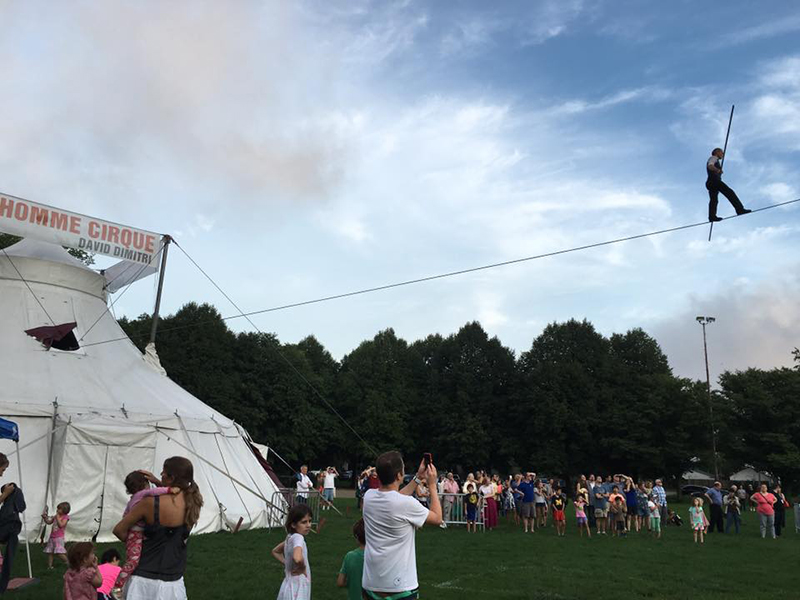
Even so, precision within each of Dimitri’s set pieces must be crucial for their successful execution, and while he clearly takes pains to get each object into the correct position, the fact that he does so so quickly and cleanly, by himself, is almost as astonishing as the feats themselves. And he never seems rushed, either. During one transition, he pretended to give a little girl in the audience a handful of feed, and as she walked over to feed the horse, at Dimitri’s urging, we all briefly believed in this flight of fancy as much as she did.
The show’s big finish, though, was far more broadly dramatic, as Dimitri pulled himself up onto another high wire, opened a flap on the tent, and waved for the audience to follow him outdoors. We tumbled out of the tent to watch him climb 150 feet into the air on a wire, toward the blue sky and clouds of the evening.
I’m pretty sure this magical sight is one that my inquisitive 5-year-old, as well as my 8-year-old, won’t soon forget.
But the same could be said of their parents, too.
Jenn McKee is a former staff arts reporter for The Ann Arbor News, where she primarily covered theater and film events, and also wrote general features and occasional articles on books and music.
L’homme Cirque ran through August 28 at Burns Park.
Fabulous Fiction Firsts #610

One of Bon Appetit's 8 New Food Novels to Read This Year - The City Baker's Guide to Country Living is a debut novel by Boston pastry chef Louise Miller.
Running away is what thirtysomething Livvy (Olivia) Rawlings does best. After her Baked Alaska sets fire to Boston's exclusive Emerson Club, she packs up and heads north to Guthrie, Vermont where her childhood (and only) friend Hannah lives. Luck would have it, the Sugar Maple Inn needs a pastry chef, a job that comes with a charming little cottage - the Sugarhouse.
Margaret Hurley, the cantankerous and demanding inn owner puts Livvy through her paces but is soon won over by Livvy's creations, along with the guests and the town-folks. Before long, Livvy finds herself immersed in small town life and intense scrutiny when she gets involved with Martin McCracken, a prodigal son who has returned to tend his ailing father.
After a Rockwell-worthy Thanksgiving, a funeral, and a surprise visitor shake things up, Livvy must decide whether to do what she does best and flee--or stay and finally discover what it means to belong.
This August Indie Next and LibraryReads pick, will appeal fo fans of Kitchens of the Great Midwest by Ryan Stradal; South of Superior by Ellen Airgood; novels by Erica Bauermesiter and the Little Beach Street Bakery series by Jenny Colgan.
Review: 10th Annual Kerrytown Nashbash Music Festival

The 10th annual Nashbash Music Festival took place in Kerrytown this past Thursday evening. Put on by the Kerrytown District Association in conjunction with the Kerrytown Concert House, the festival is a rare celebration of country music in Ann Arbor. It was a beautiful night for the event, which takes place each year in the Farmers’ Market space between Fifth and Fourth Avenues. Wolverine Brewing Company and Aut Bar slung cocktails and barbecue, and attendees could grab dinner or dessert from various food carts, including Hello Ice Cream, Petey’s Donuts and Pilar’s Tamales. Overall, the atmosphere of the festival was, as usual, relaxed and cheerful, with a wide variety of attendees. Children played and danced in the cleared parking lot, millennials busted out their cowboy boots for the occasion and sat in the sun sipping beer (this Pulp writer is upset that she forget to wear her favorite bright red cowboy boots), and older folks eagerly claimed chairs right in front of the stage to sing and clap along to the music.
Nashville singer/songwriter Sally Barris headlined this year’s festival. She’s written songs that have been recorded by a number of famous country singers including Trisha Yearwood, Keith Urban and Martina McBride, and is an extremely talented musician in her own right, currently touring with her latest album “The Road In Me.” Festival attendees were delighted with her performance last night. She played plenty of lighthearted, almost comical songs, like the one she wrote dedicated to a man who wrote his own obituary that she read about in Yahoo! News and a “Halloween love song” co-written with Don Henley. “I know what you’re thinking,” Barris joked. “Another Halloween love song?” But it wasn’t all kidding around; Barris also sang a song (later recorded by Trisha Yearwood) that she described as “deeply personal,” titled “Let the Wind Chase You. “I don’t want to work for your love/I don’t want to try to be/Something that you’re looking for/You’re never gonna find in me,” Barris sang in her clear soprano. Her set concluded with a song about a girl living in Nashville who wants to fall in love with a real cowboy, not just a guy who throws on a belt with a big buckle and some boots and believes he’s the real deal. “If I said let’s ride off into the sunset/Would you know what I mean?” Barris ended the song with a smile and a wink.
Local band Hoodang also played Nashbash. Always a delight to watch, their music is a toe-tapping blend of blues, country and rock’n’roll. Lyrics focus on, as they describe it, “people tarnished by bad blood and bad luck who still find a way to make it through to the next town, day, marriage, con or battle.” Frontman David Rossiter founded the band in 2003, and has been playing locally ever since, with various backing musicians. The current iteration has been together for several years now, though, and it seems to be working extremely well. Along with Rossiter, who plays guitar and sings, Dave Keeney plays electric guitar, Ralph McKee plays bass, John Crawford plays drums and Sophia Hanifi offers her vocal talents to round out the quintet. Hoodang isn’t particularly showy on stage, but they’re a joy to watch, simply because they seem to be having so much fun and are so comfortable together. They dedicated their song “You Don’t Tell the Truth” to presidential hopeful Donald Trump, which got laughs and cheers from the crowd. Hoodang is exactly the kind of band that one hopes to see when walking into a Nashville honky-tonk, but fortunately for Ann Arbor residents, we didn’t have to make the 9 hour drive south to see such a performance last night.
Whit Hill and the Postcards were the final performance of the evening. Hill, a longtime Ann Arborite, moved to Nashville 8 years ago and is one of the founding members of Nashbash. She scopes out acts in Nashville and selects one to bring to the festival each year. After a bit of sound trouble, Hill and the band kicked off their set with “Lotta Yer Love,” off their 2006 album Farsighted. “Don’t give me lots of money/ I don’t need your money/Just need a lotta your love,” went the rocking chorus (“She doesn’t want money, just love,” a man next to me helpfully pointed out when he saw me taking notes on the performance). The band mainly focused on songs from their 2014 album, I Dug It Up, and played a rousing version of the title track, which was a crowd favorite.
Earlier in the evening, The Bill Edwards Band, The Judy Banker Band and The Whiskey Charmers performed.
Ann Arbor is not traditionally a country music loving town, and it’s a testament to the organization of Nashbash and the talent that performs that the festival has been so successful for a decade. Even those who think they can’t bear to hear a single note of a country song would do well to check out the 11th annual Nashbash in 2017.
The 10th annual Nashbash Music Festival took place Thursday, August 18 from 5:30-9:00. The festival happens every year in mid-August and is free and open to the public.
Elizabeth Pearce is a library technician at the Ann Arbor District Library. She would also like to fall in love with a real cowboy.
Fabulous Fiction Firsts #609

“Friendship improves happiness, and abates misery, by doubling our joys, and dividing our grief.”
-Marcus Tullius Cicero
Shutting out the world beyond her Paris apartment for a whole year after the accidental deaths of her husband and young daughter, leaving management of her literary cafe Happy People Read & Drink Coffee in the hands of her well-meaning-but-not-so-capable partner Felix, Diane is finally ready to join the world of the living. Out of the blue, she announces that she will be moving to Ireland, the one place her late husband had wanted to visit.
Renting an isolated cottage in Mulranny along the wind-swept Irish coast, Diane makes tentative steps towards rebuilding her life, aided by endless cigarettes, music, copious amount of wine, friendly villagers and Postman Pat, a canine who takes an immediate liking to her. The exception being Postman Pat's owner, her neighbor - the rude and abrasive photographer, Edward, who is battling his own demons. I don't have to tell you what is likely to happen....
Agnès Martin-Lugand's debut, already an international bestseller, confronts life's most nightmarish tragedy with an unblinking examination. "For readers of women’s journeys and tales of hope, this slim volume engages thoughts and feelings without whitewashing grief." -Booklist
In development as a Weinstein Company feature film, sequel anticipated.

Journalist and translator Milena Busquets's debut This Too Shall Pass* is a lively, sexy, honest, and moving novel about a woman coming to terms with grief.
Forty year-old Blanca is wrecked with grief, losing her mother - the most important person in her life. Unable to carry on in Barcelona, she returns to her mother’s former home in Cadaqués with, among others, 2 sons, 2 ex-husbands, 2 best friends, and looking forward to meeting up with her married lover.
Surrounded by those she loves most, she spends the summer in an impossibly beautiful place, finding ways to reconnect and understand what it means to truly live on her own terms, just as her mother would have wanted.
"Witty and playful in tone as well as poignant and reflective, Busquets’ novel is drawn in part from the loss of her own mother, Esther Busquets, a prominent publishing figure in Spain. The seductions of its setting add to its appeal for American readers." -Booklist
Film rights to Buenos Aires based producer Daniel Burman.
* = starred review
Fabulous Fiction Firsts #608

“In the depth of winter, I finally learned that within me there lay an invincible summer. And that makes me happy.” -Albert Camus
Invincible Summer by Alice Adams is "a dazzling depiction of the highs and lows of adulthood, ... a story about finding the courage to carry on in the wake of disappointment, and a powerful testament to love and friendship as the constants in an ever-changing world." (Kirkus Reviews)
Eva, Benedict, and siblings Sylvie and Lucien were inseparable throughout college. Upon graduation Eva, hopelessly in love with playboy Lucien breaks away to scale the peak of global finance, and finds herself lonely in her London loft. Artistic Sylvie and carefree Lucien travel the world, looking for adventure and good times. Only Benedict stays behind, pursuing a PhD in Physics, and pining over Eva.
Over the course of 2 decades, these friends would meet up, determined to remain close while circumstances, geography, and life choices strain their relationships until tragedies draw them together again, but in ways they never could have imaged.
"Adams has crafted a light, charming tale of love, loss, and the lasting power of friendship... the characters are engaging and one cannot help but care about them. All in all, a perfect summer read." (Booklist) For fans of Meg Wolitzer's The Interestings and Lucky Us by Amy Bloom.

Chronicle of a Last Summer: a novel of Egypt by Yasmine El Rashidi traces a young Egyptian woman's coming of age through three pivotal summers, from the oppressive Mubarak era to the turbulent Arab Spring.
Cairo, 1984. the 6 year-old unnamed narrator, observant and wildly imaginative, spends the hot summer days away from her English school listening to her mother’s phone conversations, watching the three state-sanctioned TV stations with the volume off, and wondering about her father's absence - why, or to where, no one will say.
In 1998, the narrator, now a university student and an aspiring filmmaker, yearns for change but is deeply fearful of terrorism and the repression that surrounds her. Finally, as a writer in 2104, after reunited with her father, she is acutely aware of how difficult it is to affect any real change, and wonders about the silences that have marked and shaped her generation.
Yasmine El Rashidi covers Egypt and the Middle East for the The New York Review of Books, The Guardian, The New York Times, and The Wall Street Journal. She splits her time between New York City and Cairo.
Review: "Catherine Opie: 700 Nimes Road," University of Michigan Museum of Art
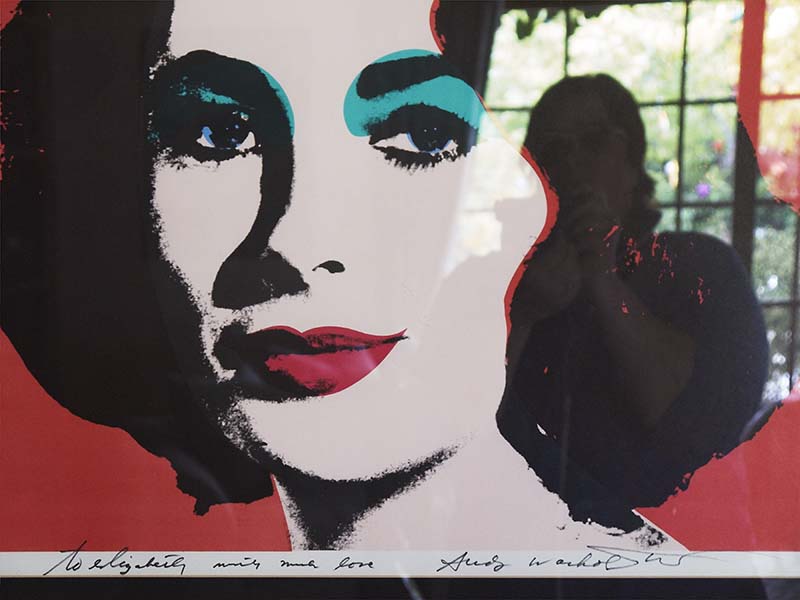
The University of Michigan Museum of Art’s Catherine Opie: 700 Nimes Road is a star-studded two-for-one visual art spectacular. 50 photographs culled from over 3,000 taken in 2010-11 by Los Angeles-based photographer Catherine Opie at the residence of actress Elizabeth Taylor, the exhibit illustrates the six months this famed contemporary photographer spent taking photos at Taylor’s Bel Air residence through the coincidental period of Taylor’s death.
Drawn from two Opie photographic series—Closets and Jewels and 700 Nimes Road—where Opie had unlimited access to Taylor’s home, the display is organized by L.A.’s Museum of Contemporary Art with lead support provided by J.P. Morgan Private Bank; philanthropists Jamie McCourt and Gilena Simons, with UMMA support provided by the U-M Health System; Bank of America; Merrill Lynch; philanthropists Alan Hergott and Curt Shepard, with additional support provided by the U-M Departments of the History of Art; Screen Arts and Cultures; and American Culture.
As we all well know, Elizabeth Taylor had a way of galvanizing attention. And the range of these supporting groups indicates how galvanizing she rightly could be. For Catherine Opie: 700 Nimes Road is as fascinating a keyhole as we could imagine of this world-famous woman’s life.
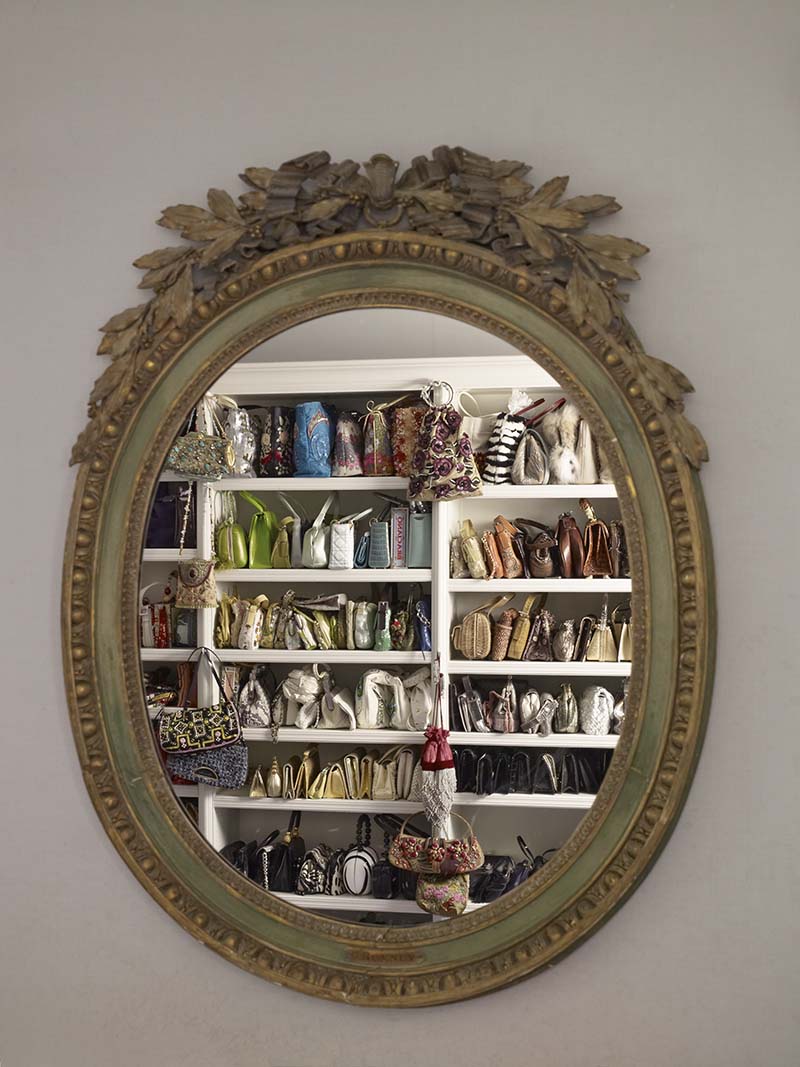
Opie herself is quite the celebrity. An award-winning photographer (and professor of photography at the University of California at Los Angeles) who works in the intersection of portraiture, landscape, and studio photography, Opie specializes in crafting transgressive imagery that knowingly blurs the intersection of private and public spaces. Mingling her expertise in a variety of photographic and printing technologies with social and political commentary, Opie has consistently produced photographs that document the shadows of our society.
By contrast, these 700 Nimes Road photographs are about as above the photojournalistic fold as Opie’s art gets. Inspired by southern photographer William Egglston’s 1984 photographs of Elvis Presley’s Graceland mansion, she and Taylor shared business manager Derrick Lee, and after negotiating with Taylor’s longtime executive assistant Tim Mendelson, Opie was given full access to 700 Nimes Road. She was busily peering in and around the corners of Taylor’s residence when the actress died of congestive heart failure on March 23, 2011
It’s this dramatic turn of events that makes 700 Nimes Road a masterful display of unceasingly studied and provocative photography. For it’s indeed a perfect melding of professional fine arts photography and screen diva as Opie never actually met Taylor in person through the course of her photographic work.
Thus what’s most fascinating about this non-meeting is the Elizabeth Taylor that Opie illustrates—and not the Elizabeth Taylor she might have met. After all, by the time of this assignment, Taylor had gone through umpteenth career cycles as a screen star ranging from guileless ingénue to international screen icon to television guest star. For Taylor shined bright at each turn of her lengthy career: Winner of two Academy Awards for Butterfield 8 (1960) and Who’s Afraid of Virginia Woolf? (1966), Taylor closed her acting career with a minor role in 1994’s The Flintstones for which she was nominated as Worst Supporting Actress by the Golden Raspberry Awards.

Yet this was also hardly the extent of Taylor’s lifework. She was an astoundingly successful businesswoman who launched her own best-selling fragrances Passion in 1987 and White Diamonds in 1991 that led to an estimated $600 million to one billion dollar personal wealth. After her death, her estate was dispersed by Christie’s auction house for a then record-breaking $156.8 million dollars with an additional $5.5 million dollars for her clothing and accessories. And her final career turn was an equally winning philanthropist for HIV/AID activism culminating with a Presidential Citizens Medal in 2001.
That’s a lot acclaim for one lifetime. So perhaps the most remarkable aspect of Opie’s art photography is her uncanny condensation of each of these many Elizabeth Taylors with visual references to her many loves—seven husbands; with countless friendships—through the sheer effect of being Elizabeth Taylor.
We certainly learn more about what it meant to be Elizabeth Taylor through Opie’s photos than through the proverbial thousand words. In some photos, Taylor’s pets make their appearance rummaging about her personal items. Other photographs feature personal Taylor keepsakes (including one photo of the box holding ex-husband Richard Burton’s 1972 gift of the famed Taj Mahal diamond necklace on her 40th birthday), with other photos featuring her raft of celebrity friends in informal guise. Yet other photographs give us extraordinary visual details of Taylor’s personal routine ranging from a massive number of orderly stashed handbags in one closet to an astounding number of awards in her “trophy room” to a single holiday ornament floating in midair.
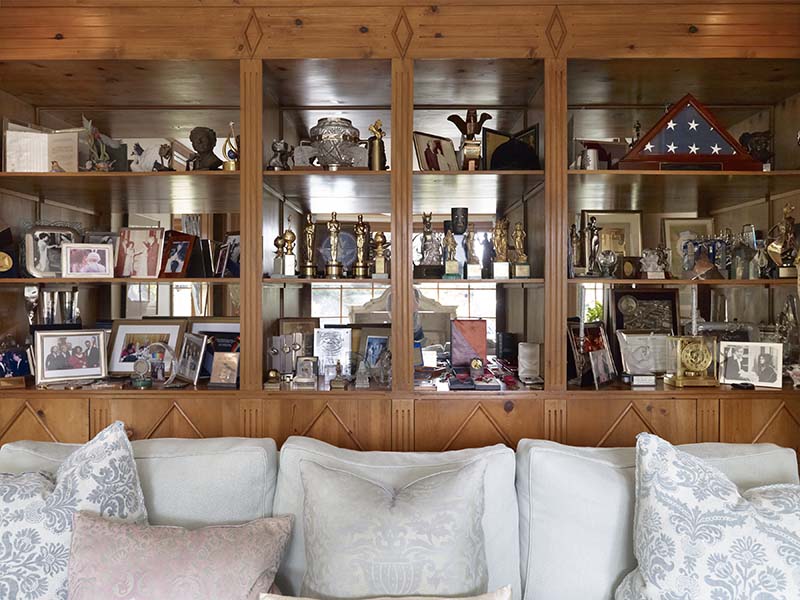
Still, fine art will stand out in fine art photography exhibits. And a single signature Opie photograph of Taylor in the abstract as reflected through the visage of her celebrity makes 2010-11’s Elizabeth (Self-Portrait, Artist) archival pigment print a first among equals in this intriguing exhibit.
The bouncing signifiers in this photograph alone make it a superior artwork. For the photo features Opie photographing herself off a bounced image of Andy Warhol’s famed 1966 silkscreen Liz #6 [Early Colored Liz].
In a career unceasingly devoted to celebrity, Warhol’s Liz #6 [Early Colored Liz] is one of his most recognizable portraits. The silkscreen features a desaturated Taylor with a sharp near-monochromatic contrast with the exception of eggshell blue eye shadow and an equally strategic contrast between his framing red background and the actress’ signature brushy bouffant brunette hair. Inferring her beauty as much as painting it, Warhol creates an idealized, romanticized image of Elizabeth Taylor that represents her public image at the height of her glory.
Opie, on the other hand, is the blurred background image to the side of Taylor in Elizabeth (Self-Portrait, Artist). Crafting a superior art photo that bounces herself sideways off the print’s framing glass, Opie links Warhol, herself, and her subject’s idealized portrait in a single image that celebrates Taylor mystique as well as her own personal property autographed by Warhol with the phrase “with much love.”
In a single masterly image, Opie shows us how this actress held—and continues to hold—such strong affect on our emotions to this day. Opie’s Elizabeth (Self-Portrait, Artist) self-reflexively recalls Liz #6 [Early Colored Liz] today with as much love as Taylor was able to engender then.
John Carlos Cantú has written on our community's visual arts in a number of different periodicals.
University of Michigan Museum of Art: “Catherine Opie: 700 Nimes Road” will run through September 11, 2016. The UMMA is located at 525 S. State Street. The Museum is open Tuesday-Saturday 11 a.m.–5 p.m.; and Sunday 12–5 p.m. For information, call 734-764.0395.


































